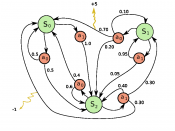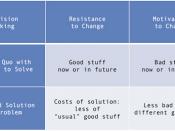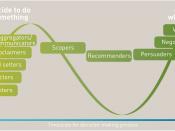Running head: SCENARIO
Scenario Based Method
Lee Johnston
University of Phoenix
March 2, 2004
Abstract
Dramatic scenario belongs to the family of qualitative methods of futures research, to be more exact, to the family of qualitative scenarios. With the help of the method it is possible to create crosscut -scenarios describing a state of society or part of it at defined moment in futures history. The more sophisticated use is to create path-scenarios, descriptions of possible paths to the defined end states.
Scenario Based Method
It is hardly possible to recognize societal challenges using conventional methods of social or legal sciences. Instead, futures research provides more suitable methods. Scenario-based method offers a scientific basis for describing future states and evaluating them from the present day perspective. In addition to legal issues,
Similar methods can be applied to other IT related research that is interested in the human environment where the technology will be actually used.
This includes for example studies in business models, economic development, social planning and the usability of technology.
Method
Scenario based decision making provides managers with information along with instructions that are intended to perk up his or her assessment building talent. This outline will allow administration to embark on scenario sketching which is the foundation for the decision - making method. Scenario improvement examines the significant questions that implicate substantial doubts along with outside influences on an establishment. Contrasting with tactical development, which postulates a solitary outlook, scenario preparation looks at more than a few alternative versions of the impending future, anyone of these may or may not happen. (Van der Weff) The nine steps in scenario sketches are involved with everything from talking about the issues about implementing the decisions in an appropriate amount of time. These nine steps are (Van der Weff):
v First, specify the major issue or decision you are facing. For instance sitting of a new-found tree, entering into an international coalition, mounting the company's impressive approach, or revamping product allocation.
v Second, isolate the key drivers - those external forces affecting your company and industry. Drivers fall into two categories. Predetermined elements are somewhat constant or unsurprising. For an example, the demographics of the populations. Critical uncertainties are unbalanced or irregular.
v Third, select the two most important drivers. Do not cause difficulties with scenarios by choosing too many drivers. Try to limit oneself to formulating three or four scenarios with stridently divergent futures: (1) The baseline, business as usual, world as it is surprise - free scenario; (2) the scenario which driver A alone dominates; (3) the scenario which driver B alone dominates; and (4) perhaps one with both drivers present.
v Fourth, write a short internally consistent story's of the future which highlights the key driver or drivers for each scenario.
v Fifth, give each scenario a pithy name; Examples include
÷ High Road
÷ Boomor Bust
÷ Fortress of Asia
÷ Lift Off
Names help to keep participants to keep the scenarios disconnected, make available common language for discussing, and give the scenarios some permanence within the company outside of the formal process.
v Sixth, within each scenario determine the implications for the issues or decisions specified at the outset. Be precise.
v Seventh, with these implications in mind, discuss what one's decision or business response should be. One should remember that nothing one does is done in a vacuum. How might our government react under each scenario? Our clients or customers? Your competitors?
v Eighth, select indicators which suggest that a particular scenario is unfolding. Since there is a bias towards eventual action, choose those indicators which will precipitate action when a particular threshold is reached. Track and discuss these indicators regularly and update one's scenarios accordingly.
v Finally, usually at some future date, make those decisions in a timely manner that is appropriate for the particular future that does unfold. Future realism, of course, is not likely to be exact in accordance with any of one's scenarios, but the flexible frame of mind development during the scenerario planning enables one to react nimbly to certain events that do happen. One does not choose among the scenario. Rather, one will use them all in order to help form a hypotheses about the world and to recognize which items are operative at any given time.
These above scenario planning steps are much an art as a science in developing scenarios. This is because the process is an orderly one to describe though it is a bit messier to execute!
Dr. Weff has suggested that following the three drivers are chosen, participants must chose a scenario panel to be associated with and that the remaining steps should be completed within each scenario team who are located at different locations in the same room. These panels ought to look at the point of view of how assessment - developers would come across a problem and place limits on certain parts of the condition that needs to be considered critical. This is the point as well in which discussion must consist of parts of the organization that might be affected with their consequential decision. There are countless times in which the decision - making process will not capture into account the ramifications of the final result could have on other areas of an organization.
As each one is finished, each scenario group gives information along with his or her beliefs. Once all the steps have been accomplished, the strategies anticipated by each scenario are reviewed and the whole group reaches an agreement on the one or two preeminent strategies to engage in. In spite of, if it is directly associated to the problem that is being faced (Werff). The actual likelihood that the entire group should draw closer to an undisputed verdict is doubtful but everyone ought to be eager to finding the middle ground or at least come to a mutual concurrence on some of the items. The information - gatherers have to look for foreseeable details and options to manufacture a pratacle evaluation of the "unknowable" to make possible the decision - making in the faces of uncertainty (Russo). Taking into deliberation all the potential external factors that could have an effect on and decision is a key factor of those steps. Even the strongest fight for a confident decision can be devastating if an unknown external element can have even the smallest influence on its outcome.
Throughout the process of gathering information, the groups must avoid dangers for instance, relying on their contemporary principle and the propensity to search for information that confirms his or her predetermined thinking. Teams need to be consisted of individuals from different areas of a society. This will help to ensure that all the bases are covered, with an entire team is getting facts about the other areas thus permitting him or her to make informed decisions.
Only by exhaustively learning the knowledge from the outcome of previous decisions; Decision - makers persistently try to enhance his or her skills. Additionally, if the learning starts when a decision is first implemented, or during the initial improvements to the decision or the execution approach can be developed. This could represent the dissimilarity involving achievement and disappointment. Time and again, by not looking at preceding experience, organizations may repeat their mistakes.
Limitations / Example
When a number of organizations are offered with a critical predicament, these organizations generally do not consider that relying on scenario - based decision making should resolve their issues in the future. For instance, undersized companies in general could rely on consulting organizations for all their decision making would not have sufficient means to establish the teams that are needed for scenario - based decision making. For places that choose to make use of the scenario - based decision making, the complexity would lie in the assortment of team members. If the proper team members are too picked, disastrous choices could me made and eventually the decision making procedure will fail.
Even though we are a department that deals with several services, we seem to have several ways that we handle our services. When I began with the local government over three years ago, there was only one way we did things. This included all daily operations. Nevertheless, these options are not always for the advantage for the government. Many of these options have included ways to bandage our systems and networks, thus having some decreased productivity. If we would have fixed the problems correctly before we could be more productive in fixing other problems.
Discussion
The scenario - based decision making is an exceptionally supportive means that could assist many of organizations to make proper critical decisions. This method gives managers and teams to form a guideline by which they can develop informal decisions and allow one to improve future decisions.
References
van der Werff, Dr. Terry J., CMC (2000). Scenario-Based Decision Making - Technique. Retrieved February 28, 2004, from http://www.globalfuture.com/scenario1.htm
Russo, J. Edward, Shoemaker, Paul J.H., and Hittleman, Margo (2002). A Good Decision-Making Process. CUES. Retrieved February 24, 2004, from http://www.cues.org/fyi/n70802.html


